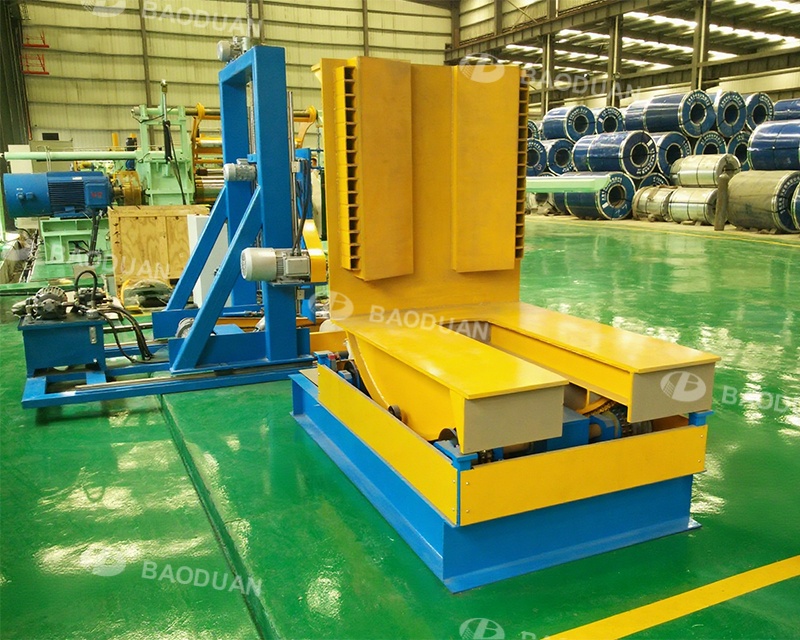Choosing the appropriate roll flipping machine model requires a comprehensive evaluation of core dimensions such as roll characteristics, production scenario requirements, safety and automation requirements, in order to avoid low efficiency, equipment loss or safety risks caused by mismatched models. The following is the step-by-step selection logic and key considerations:
Prioritize clarifying core parameters: the characteristics of the coil determine the basic capabilities of the equipment
The physical parameters of the coil material are the "hard threshold" for selecting the flipping machine model, which directly determines whether the equipment can carry and stably flip.
Matching production scenarios: Determine equipment functionality and efficiency based on process requirements
The requirements for "action efficiency," "automation level," and "spatial adaptability" of flipping machines vary greatly in different production scenarios, and need to be selected based on actual processes
1. Select according to the "flipping requirement": confirm the flipping angle and action accuracy
90 ° flipping: commonly seen in "coil vertical placement → flat placement" or "flat placement → vertical placement". Choose the "single axis flipping" model and pay attention to the flipping angle error.
180 ° Flip: Used for switching between the front and back of the coil, the "dual axis linkage" or "flip frame can rotate 360 °" model should be selected, and an "angle encoder" should be equipped.
Multi angle adjustable: suitable for multi process compatible scenarios, choose electronic control models with "programmable angle memory", support preset multiple flipping angles.
2. Select according to "production efficiency": confirm the compatibility between flipping speed and rhythm
Low speed overload scenario: The flipping speed does not need to be too fast, and priority should be given to ensuring "stability" by selecting a high torque motor and a transmission mechanism with a large reduction ratio.
High speed production line scenario: To match the production line rhythm, select the "servo motor drive"+"lightweight flipping frame" model, with a flipping speed of up to 20-30 °/s and support for "continuous start stop".
3. Select according to "space constraints": adapt to workshop layout and handling path
Narrow space scene
High space scenario: If you need to use it with a crane/overhead crane, choose the "top lifting" flipping machine or the "floor standing+adjustable" model.
Assessing Automation and Security: Determine Control and Protection Levels Based on Management Requirements
1. Automation level: Balancing "labor costs" and "equipment investment"
Manual/semi-automatic: suitable for small batch and low-frequency operations, the equipment only requires basic start stop control, with low cost, but manual assistance is required to locate the coil.
Fully automatic: suitable for large-scale, continuous production, requiring the following functions:
-Linkage with production line PLC;
-Automatic positioning of coil material;
-Automatic fault alarm.
2. Safety protection: Avoid personal and equipment risks during operation
It is necessary to confirm that the equipment has the following safety design, especially for heavy-duty coils:
Overload protection: The motor is equipped with a "thermal overload relay", or the electronic control system is equipped with a "weight sensor";
Clamping anti loosening: hydraulic clamping mechanism with "pressure holding valve", or mechanical clamping with "self-locking structure";
Emergency stop: An "emergency stop button" should be installed around the equipment, and when the emergency stop is triggered during the flipping process, it can be "smoothly braked";
Protective fence/light curtain: A physical protective fence or infrared light curtain is installed in the flipping area.
Reference additional requirement: Improve adaptability and economy for long-term use
1. Compatibility: Is it necessary to adapt to multi specification rolls
If the workshop needs to handle rolls of multiple diameters/weights, the "adjustable" model is preferred:
The support spacing can be manually/electrically adjusted;
The clamping mechanism is equipped with "multi gear size adaptation".
2. Maintenance cost: Pay attention to vulnerable parts and after-sales service
Vulnerable parts: Confirm whether the transmission mechanism and clamping cushion layer are "standardized accessories";
After sales: Choose brand manufacturers to ensure on-site maintenance and spare parts supply.
3. Energy consumption and environmental protection: long-term economic viability
High power models: choose motors with "variable frequency speed regulation" function;
Hydraulic drive model: Confirm that the hydraulic system has no leaks.

Summary: Selection Decision Process
Confirm the parameters of the coil material: weight, diameter, material → lock the rated load-bearing and support dimensions of the equipment;
Clarify scene requirements: flip angle, efficiency, space → determine equipment action type and size;
Evaluate automation and safety: production batch, risk level → select control methods and protective design;
Verify additional requirements: compatibility with multiple specifications, maintenance costs → finalize the model.
Through the above steps, it can be ensured that the selected roll flipping machine not only meets current production needs, but also has long-term stability and economy for use.

Shanghai Baoduan Machinery Manu-facturing Co., LTD is located inBaoshan DistrictShanghai. Is a professional equipment manufacturing.

About
Copynght @ Shanghai Baoduan Machinery Manufacturing Co, LTD. All rights reserved
SitemapThis website uses cookies to ensure you get the best experience on our website.
Comment
(0)